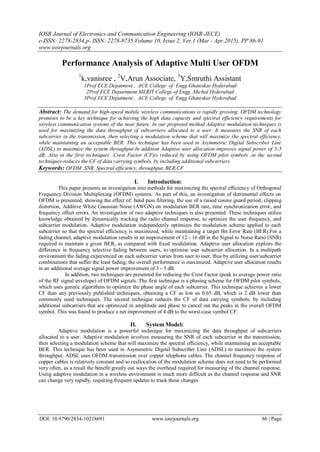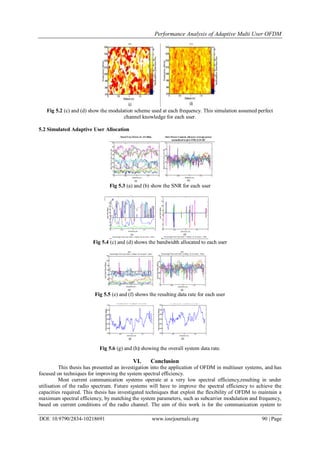This document summarizes research on performance analysis of adaptive multi-user OFDM systems. It describes using adaptive modulation to maximize throughput by selecting modulation schemes on a per-subcarrier basis to maintain bit error rate while maximizing spectral efficiency. Adaptive user allocation is also analyzed to improve signal power by optimizing user-subcarrier combinations based on frequency selective fading differences between users. Simulation results show adaptive modulation providing 12-16dB SNR improvement over fixed modulation. Adaptive user allocation provides an additional 3-5dB average signal power gain. The document concludes these adaptive techniques allow OFDM systems to approach channel capacity limits given constraints of the radio channel, transmitter power and quality of service requirements.



![Performance Analysis of Adaptive Multi User OFDM
DOI: 10.9790/2834-10218691 www.iosrjournals.org 89 | Page
Peer-to-peer networking requires that all stations can communicate with each other. As a result most systems
use half duplex communications and transmit and receive at the same frequency.
4. 1 Adaptive Modulation
Adaptive modulation is a powerful technique for maximizing the data throughput of subcarriers
allocated to a user. Adaptive modulation involves measuring the SNR of each subcarrier in the transmission,
then selecting a modulation scheme that will maximize the spectral efficiency, while maintaining an acceptable
BER. This technique has been used in Asymmetric Digital Subscriber Line (ADSL) [86], [87],[88], to maximize
the system throughput. ADSL uses OFDM transmission over copper telephone cables. The channel frequency
response of copper cables is relatively constant and so reallocation of the modulation scheme does not need to
be performed very often, as a result the benefit greatly out ways the overhead required for measuring of the
channel response. Using adaptive modulation in a wireless environment is much more difficult as the channel
response and SNR can change very rapidly, requiring frequent updates to track these changes. Most OFDM
systems use a fixed modulation scheme over all subcarriers for simplicity. However each subcarrier in a
multiuser OFDM system can potentially have a different modulation scheme depending on the channel
conditions. Any coherent or differential, phase or amplitude modulation scheme can be used including BPSK,
QPSK, 8-PSK, 16-QAM, 64-QAM, etc, each providing a trade off between spectral efficiency and the bit error
rate. The spectral efficiency can be maximized by choosing the highest modulation scheme that will give an
acceptable Bit Error Rate (BER). In a multipath radio channel, frequency selective fading can result in large
variations in the received power of each subcarrier. For a channel with no direct signal path this variation can be
as much as 30 dB in the received power resulting in a similar variation in the SNR. In addition to this,
interference from neighboring cells can cause the SNR to vary significantly over the system bandwidth. To cope
with this large variation in SNR over the system subcarriers, it is possible to adaptively allocate the subcarrier
modulation scheme, so that the spectral efficiency is maximized while maintaining an acceptable BER.
4.2 Limitations Of Adaptive Modulation:
There are several limitations with adaptive modulation. Overhead information needs to be transferred,
as both the transmitter and receiver must know what modulation is currently being used. Also as the mobility of
the remote station is increased, the adaptive modulation process requires regular updates, further increasing the
overhead. There is a trade off between power control and adaptive modulation. If a remote station has a good
channel path the transmitted power can be maintained and a high modulation scheme used (i.e. 64-QAM), or the
power can be reduced and the modulation scheme reduced accordingly (i.e. QPSK). Distortion, frequency error
and the maximum allowable power variation between users limit the maximum modulation scheme that can be
used. The received power for neighboring subcarriers must have no more than 20 - 30 dB variation at the base
station, as large variations can result in strong signals swamping weaker subcarriers. Inter-modulation distortion
results from any non-linear components in the transmission, and causes a higher noise floor in the transmission
band, limiting the maximum SNR to typically 30 - 60 dB. Frequency errors in the transmission due to
synchronization errors and Doppler shift result in a loss of orthogonality between the subcarriers. A frequency
offset of only 1 - 2 % of the subcarrier spacing results in the effective SNR being limited to 20 dB . The limited
SNR restricts the maximum spectral efficiency to approximately 5 - 10 b/s/Hz.
V. Simulation Results:
5.1 Simulated Results Each User Having Fixed Transmision Power
Results shown in (a) and (c) are for each user having a fixed transmission power. The transmitter
power in (b) and (d) were set so that the average received power would result in an average SNR of 20 dB
Fig 5.1 (a) and (b) show the frequency allocations for each of the users. Each user is shown as a different colour](https://image.slidesharecdn.com/l010218691-160729100707/85/L010218691-4-320.jpg)

![Performance Analysis of Adaptive Multi User OFDM
DOI: 10.9790/2834-10218691 www.iosrjournals.org 91 | Page
approach the maximum theoretical channel capacity given the constraints of the radio channel, transmitter
power and quality of service.
The application of adaptive modulation was investigated and found to provide an effective means to
mitigate the effects of fading. Adaptive modulation greatly decreases the BER, with it requiring 12 - 16 dB less
SNR to achieve the same BER as compared with a fixed modulation system. In addition to this, it allows the
data rate of the system to improve when the channel SNR is high. When using coherent QAM, every 3 dB
improvement in SNR allows the spectral efficiency of the system to improve by 1 b/s/Hz.
References:
[1]. K. W. Richard, “UMTS overview”, IEE Electronics and CommunicationEngineering Journal, Vol. 12, No. 3, June 2000, pp. 93 -
100
[2]. Ermanno Berruto, Giovanni Colombo, Pantelis Monogioudis, Antonella Napolitano, Kyriacos Sabatakakis, “Architectural Aspects
for the Evolution of Mobile Communications Toward UMTS”, IEEE Journal on Selected Areas in Communications, Vol. 15, No. 8,
October 1997,pp. 1477 - 1487
[3]. Erik Dahlman, Björn Gudmundson, Mats Nilsson, Johan Sköld, “UMTS/IMT-2000 Based on Wideband CDMA”, IEEE
Communications Magazine, September 1998, pp. 70 - 80
[4]. Fumiyuki Adachi, Mamoru Sawahasi, Hirohito Suda, “Wideband DS-CDMA for Next-Generation Mobile Communications
Systems”, IEEE Communications Magazine, September 1998, pp. 56 - 69
[5]. M. Fattouche, “Method and Apparatus for Multiple Access between Transceivers in Wireless Communications using OFDM spread
spectrum”, U.S. Patent 5,282,222, Filed Mar. 31, 1992, Issued Jan. 25, 1994
[6]. T. Williams, R. Prodan, “Multiple User Access Method Using OFDM”, U. S. Patent 5,815,488, Filed Sep. 28, 1995, Issued Sep. 29,
1998
[7]. L. Cimini, J. Chuang, N. Sollenberger, “Advanced Cellular Internet Service (ACIS)”, IEEE Communications Magazine, Oct. 1998,
pp. 150 – 159
[8]. Minh T. Le, Louis Thibault, “Performance Evaluation of COFDM for Digital Audio Broadcasting Part II: Effects of HPA
Nonlinearities”, IEEE Transactions on Broadcasting, Vol. 44, No. 2, June 1998, pp. 165 – 171
[9]. S. Merchán, A. García Armada, J. L. García, “OFDM Performance in Amplifier Nonlinearity”, IEEE Transactions on Broadcasting,
Vol. 44, No. 1, March 1998, pp. 106 - 113
[10]. Qun Shi, “OFDM in Bandpass Nonlinearity”, IEEE Transactions on Consumer Electronics, Vol. 42, No. 3, August 1996, pp. 253 -
258](https://image.slidesharecdn.com/l010218691-160729100707/85/L010218691-6-320.jpg)